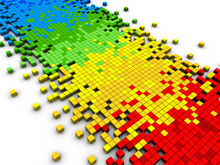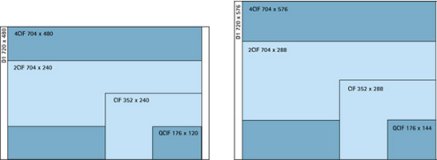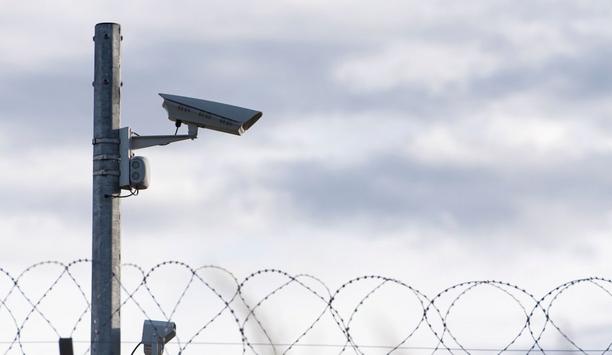 |
| Analogue and digital resolutions are worlds apart |
In analogue video, an image consists of lines or TV-lines since analogue video technology is derived from the television industry. In a digital system, an image is made up of square pixels.
NTSC and PAL - analogue video standards
NTSC (National Television System Committee) and PAL (Phase Alternating Line) resolutions are analogue video standards. They are relevant to network video since video encoders provide such resolutions when they digitize signals from analogue cameras. Current PTZ network cameras and PTZ dome network cameras also provide NTSC and PAL resolutions since such cameras today use a camera block (which incorporates the camera, zoom, auto-focus and auto-iris functions) made for analogue video cameras, in conjunction with a built-in video encoder board.
In North America and Japan, the NTSC standard is the predominant analogue video standard, while in Europe and many Asian and African countries, the PAL standard is used. Both standards originate from the television industry. NTSC has a resolution of 480 lines and uses a refresh rate of 60 interlaced fields per second (or 30 full frames per second). A new naming convention, which defines the number of lines, type of scan and refresh rate, for this standard is 480i60 ("i" stands for interlaced scanning). PAL has a resolution with 576 lines and uses a refresh rate of 50 interlaced fields per second (or 25 full frames per second). The new naming convention for this standard is 576i50. The total amount of information per second is the same in both standards.
When analogue video is digitised, the maximum amount of pixels that can be created is based on the number of TV lines available to be digitised. The maximum size of a digitised image is typically D1 and the most commonly used resolution is 4CIF.
|
|
| On the left showing different NTSC image resolutions, on the right showing different PAL image resolutions |
When shown on a computer screen, digitised analogue video may show interlacing effects such as tearing and shapes may be off slightly since the pixels generated may not conform to the square pixels on the computer screen. Interlacing
 |
| VGA resolution is better suited for network cameras as it is based on square pixels |
Benefits of VGA resolutions
With 100% digital systems based on network cameras, resolutions that are derived from the computer industry and that are standardised worldwide can be provided, allowing for better flexibility. The limitations of NTSC and PAL become irrelevant.
VGA (Video Graphics Array) is a graphics display system for PCs originally developed by IBM. The resolution is defined as 640x480 pixels, which is a common format used by non-megapixel network cameras. The VGA resolution is normally better suited for network cameras since VGA based video produces square pixels that match with those on computer screens. Computer monitors can handle resolutions in VGA or multiples of VGA.
VGA resolutions: Display format | Pixels |
| QVGA (CIF) | 320x240 |
| VGA | 640x480 |
| SVGA | 800x600 |
| XVGA | 1024x768 |
| 4x VGA | 1024x768 |

Phil Doyle
Managing Director (UK & Ireland)
Axis Communications




















